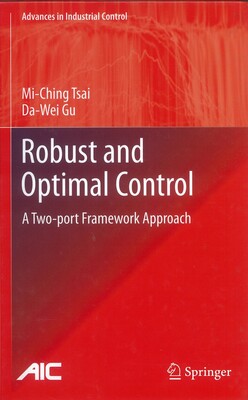Robust and Optimal Control-A Two-port Framework Approach

Robust and Optimal Control:
A Two-port Framework Approach
Mi-Ching Tsai and Da-Wei Gu
Department of Mechanical Engineering
National Cheng Kung University
Springer-Verlag London, 2014
ISBN: 978-1-4471-6256-8
ISBN (ebook): 978-1-4471-6257-5
Abstract
A Two-port Framework for Robust and Optimal Control introduces an alternative approach to robust and optimal controller synthesis procedures for linear, time-invariant systems, based on the two-port network system widespread in electrical engineering. The novel use of the two-port system in this context allows straightforward engineering-oriented solution-finding procedures to be developed, requiring no complex mathematics beyond linear algebra. A chain-scattering description provides a unified framework for constructing the stabilizing controller set and for synthesizing H2 optimal and H∞ sub-optimal controllers. Simple yet illustrative examples explain each step.
A Two-port Framework for Robust and Optimal Control features:
· A tutorial-style presentation giving the reader the opportunity to repeat the designs presented and to easily modify them for their own programs;
· An abundance of examples illustrating the most important steps in robust and optimal design;
· End-of-chapter exercises.
To further demonstrate the proposed approaches, in the last chapter, an application case study is presented to demonstrate the use of the framework in servo control system design that helps the readers quickly move on with their own challenges. MATLAB® codes used in examples throughout the book and the solutions to selected exercise questions are available for download from the website.
The text context will have particular resonance for researchers in control with electrical engineering background, who wish to avoid spending excessive time in learning complex mathematical, theoretical developments, but need to know how to deal with robust and optimal control synthesis problems.
摘要
隨著現代科學技術和生產自動化的發展,控制系統的性能要求也越來越高,由於受控系統的數學建模會有近似上的不確定性,感測上亦有測量上的不準確性,以及控制系統本身的參數變化等,設計控制器時,一般只能在近似簡化的基礎上進行,而傳統的設計方法很難系統化確保所需的動態控制性能,且對特定的不確定因素具有強健性功能,強健控制設計方法因此蘊育而生。然而,常見的強健控制法則其數學理論推導是非常數學化且複雜的,對工程領域初學者而言是相當不容易的。本書透過電機工程領域的電路雙端網路法,化繁為簡的數學式推演,初學者能用直觀的方式,系統化求得H2 以及 H∞ 最佳化控制器。以下為本書的特點:
- 教學式的書寫方式,賦予讀者臨摹書中所呈現設計的機會,並可輕易編修以適用於自己的程式。
- 為了讓讀者更清楚的了解設計過程,本書設計許多例子,並清楚的描述各個重要步驟。
- 每章節末附有習題範例,增加讀者自我的練習機會。
在最後一章節,透過一個實用例說明強健系統控制器的設計流程,讓讀者能更進一步了解本書所發展的學理及設計方法,並延伸至解決自己的應用實例。此外,本書作者亦架設網頁提供各章節範例的解答及MATLAB®程式碼,可供讀者網路下載。對於控制及電機工程領域的研究人員,可透過本書充份理解強健性最佳控制完整的設計概念,並可避免一開始就需學習太多複雜的數學理論。

